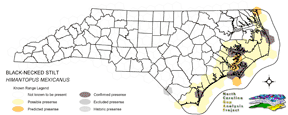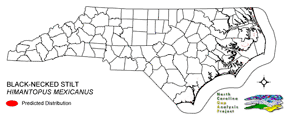
| Taxa: |
| Order: |
| Family: |
| Aves |
| Charadriiformes |
| Recurvirostridae |
| NatureServe Global Rank: |
| NatureServe State (NC) Rank: |
| G5 |
| S2B |
| Federal Status: |
| NC State Status: |
| --- |
| SR |


| Land Unit |
| US Fish & Wildlife Service |
| US Forest Service |
| US National Park Service |
| US Department of Defense |
| NC State Parks |
| NC University System |
| NC Wildlife Res. Com. |
| NC Forest Service |
| NC Div. of Coastal Mgmt. |
| Local Governments |
| Non-Governmental Org. |
| Other Public Lands |
| Private Lands |
| GAP Status 1-2 |
| All Protected Lands |
| Statewide |
| Hectares |
| 10,701.90 |
| 294.57 |
| 4,674.24 |
| 5,413.86 |
| 1,337.40 |
| 3.96 |
| 2,642.49 |
| 0.00 |
| 1,421.10 |
| 7.83 |
| 1,201.77 |
| 21.87 |
| 49,675.95 |
| 20,230.29 |
| 27,495.54 |
| 77,396.94 |
| Acres |
| 26,444.97 |
| 727.90 |
| 11,550.30 |
| 13,377.94 |
| 3,304.79 |
| 9.79 |
| 6,529.73 |
| 0.00 |
| 3,511.61 |
| 19.35 |
| 2,969.64 |
| 54.04 |
| 122,751.92 |
| 49,990.13 |
| 67,942.95 |
| 191,251.97 |
| % of Dist. on |
| Prot. Lands |
| 38.9 % |
| 1.1 % |
| 16.2 % |
| 19.7 % |
| 4.9 % |
| < 0.1 % |
| 9.6 % |
| 0.0 % |
| 5.2 % |
| 4.4 % |
| 4.4 % |
| < 0.1 % |
| 0.0 % |
| 73.6 % |
| ----- |
| ----- |
| % of Dist. on |
| All Lands |
| 13.8 % |
| 0.4 % |
| 6.0 % |
| 7.0 % |
| 1.7 % |
| < 0.1 % |
| 3.4 % |
| 0.0 % |
| 1.8 % |
| < 0.1 % |
| 1.6 % |
| < 0.1 % |
| 64.2 % |
| 26.1 % |
| ----- |
| ----- |
|
Common at Pea Island National Wildlife Refuge, Bodie Island, and Cape Romain; otherwise uncommon and very local in the coastal area (Fussell 1994, Potter et al. 1980). Feeds in shallow fresh or brackish water such as in ponds (Potter et al. 1980), mudflats, grassy marshes, impoundments, and other non-tidal areas (Fussell 1994), especially where there is emergent vegetation (Kaufman 1996). Nesting site is in an open area (Ehrlich et al. 1988). Eggs are laid on the ground in a dry place or on a mound of mud in shallow water (Harrison 1975), and may or may not be partially concealed (Ehrlich et al. 1988), presumably by debris (Kaufman 1996). NATURE SERVE GLOBAL HABITAT COMMENTS: Shallow salt or fresh water with soft muddy bottom; grassy marshes, wet savanna, mudflats, shallow ponds, flooded fields, borders of salt ponds and mangrove swamps (Tropical to Temperate zones) (AOU 1983, Raffaele 1983). Nests along shallow water of ponds, lakes, swamps, or lagoons. May nest on the ground or in shallow water on a plant tussock. |
| Code | Name | Description | NC Natural Heritage Program Equivalent |
| 3 | Tidal Marsh | Fresh and brackish tidal marshes, including cord grass, wild rice, sawgrass and needlerush alliances. | Brackish Marsh, Interdune pond, Maritime wet grassland |
| 375 | Hypersaline coastal salt flats | Tidal flats within salt marshes, including saltmeadow cordgrass or sea-purslane dominated alliances. | Salt Marsh |
| 372 | Interdune Herbaceous Wetlands | Dune swales with permanently flooded to intermittently exposed hydrology. Species composition depends on salinity and can include cut grass, spike-rush, mosquito fern, and hornwort. | Interdune Pond, Maritime Wet Grasslands |
| 371 | Maritime Grasslands | Dune grass community consisting of sea oats and beach grasses. | Dune grass, Maritime dry grassland |
| 380 | Coastal Plain Fresh Water Emergent | Emergent vegetation in fresh water seepage bogs, ponds and riverbeds of the coastal plain. Includes alliances dominated by sedges, eelgrass, as well as cane found in unforested cane-brakes. | Small Depression Pond, Sandhill Seep, Floodplain Pool, Unforested Floodplain Canebrake, Riverscour Prairies, Vernal Pools |
| 8 | Open water | Open water without aquatic vegetation. | No equivalent |
|
Fussell, J.O. III. 1994. A birderís guide to coastal North Carolina. Chapel Hill and London: The University of North Carolina Press.
Kaufman K. 1996. Lives of North American Birds. Boston, New York: Houghton Mifflin Company. Oberholser, H.C. 1974. The bird life of Texas. 2 vols. Univ. of Texas Press, Austin. Harrison, H.H. 1975. A field guide to bird's nests in the U.S. east of the Mississippi River. Houghton Mifflin Company, Boston, Massachusetts. 257 p. Harrison, C. 1978. A field guide to the nests, eggs and nestlings of North American birds. Collins, Cleveland, Ohio. Potter, E. F., J. F. Parnell, and R. P. Teulings. 1980. Birds of the Carolinas. Univ. North Carolina Press, Chapel Hill. 408 pp. Terres, J.K. 1980. The Audubon Society encyclopedia of North American birds. Alfred A. Knopf, New York. Berger, A.J. 1981. Hawaiian Birdlife. Second Edition. University of Hawaii Press, Honolulu, Hawaii. xv + 260 pp. American Ornithologists' Union (AOU), Committee on Classification and Nomenclature. 1983. Check-list of North American Birds. Sixth Edition. American Ornithologists' Union, Allen Press, Inc., Lawrence, Kansas. Raffaele, H.A. 1983. A guide to the birds of Puerto Rico and the Virgin Islands. Fondo Educativo Interamericano, San Juan, Puerto Rico. 255 pp. Ehrlich, P.R., D.S. Dobkin, and D. Wheye. 1988. The birder's handbook:a field guide to the natural history of North American birds. Simon and Shuster, Inc., New York. xxx + 785 pp. Stiles, F.G., and A.F. Skutch. 1989. A guide to the birds of Costa Rica. Comstock Publ. Associates, Cornell University Press, Ithaca, New York. 511 pp. Sibley, C.G., and B.L. Monroe. 1990. Distribution and taxonomy of birds of the world. Yale University Press, New Haven, Connecticut. xxiv + 1111 pp. |
For more information please contact them at:
NC-GAP Analysis Project
Dept. of Zoology, NCSU
Campus Box 7617
Raleigh, NC 27695-7617
(919) 513-2853
www.basic.ncsu.edu/ncgap